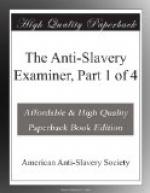Sarah his wife, and Lot his brother’s son, and
all their SUBSTANCE that they had gathered; and the
souls that they had gotten in Haran, and they went
forth to go into the land of Canaan.” Gen.
xii. 5. Many will have it, that these souls
were a part of Abraham’s substance (notwithstanding
the pains here taken to separate them from it)—that
they were slaves taken with him in his migration as
a part of his family effects. Who but slaveholders,
either actually or in heart, would torture into the
principle and practice of slavery, such a harmless
phrase as “the souls that they had gotten?”
Until the African slave trade breathed its haze into
the eyes of the church and smote her with palsy and
decay, commentators saw no slavery in, “The souls
that they had gotten.” In the Targum of
Onkelos[A] it is rendered, “The souls whom they
had brought to obey the law in Haran.” In
the Targum of Jonathan, “The souls whom they
had made proselytes in Haran.” In the Targum
of Jerusalem, “The souls proselyted in Haran.”
Jarchi, the prince of Jewish commentators, “The
souls whom they had brought under the Divine wings.”
Jerome, one of the most learned of the Christian fathers,
“The persons whom they had proselyted.”
The Persian version, the Vulgate, the Syriac, the
Arabic, and the Samaritan all render it, “All
the wealth which they had gathered, and the souls
which they had made in Haran.” Menochius,
a commentator who wrote before our present translation
of the Bible, renders it, “Quas de idolatraria
converterant.” “Those whom they had
converted from idolatry.” Paulus Fagius,[B]
“Quas instituerant in religione.”
“Those whom they had established in religion.”
Luke Francke, a German commentator who lived two centuries
ago, “Quas legi subjicerant.”—“Those
whom they had brought to obey the law.”
The same distinction is made between persons
and property, in the enumeration of Esau’s household
and the inventory of his effects. “And Esau
took his wives and his sons and his daughters, and
all the persons of his house, and his cattle,
and all his beasts, and all his substance which
he had got in the land of Canaan, and went into the
country from the face of his brother Jacob. For
their riches were more than that they might
dwell together; and the land could not bear them because
of their cattle.” Gen. xxxvi. 6,
7.
[Footnote A: The Targums are Chaldee paraphrases of parts of the Old Testament. The Targum of Onkelos is, for the most part, a very accurate and faithful translation of the original, and was probably made at about the commencement of the Christian era. The Targum of Jonathan Ben Uzziel, bears about the same date. The Targum of Jerusalem was probably about five hundred years later. The Israelites, during their captivity in Babylon, lost, as a body, their own language. These translations into the Chaldee, the language which they acquired in Babylon, were thus called for by the necessity of the case.]




